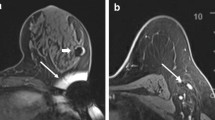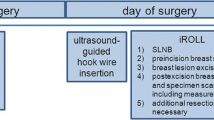Abstract
To investigate the most commonly used technique, the wire-guided localization (WGL) in non-palpable breast cancer. To analyze the effective factors on positive surgical margins in our practice and determine the surgical learning curve of this method. Prospective consecutive study was performed from January 2005 to December 2011. Inclusion criteria was a non-palpable breast lesion with malignancy on preoperative histology. All lesions were localized by ultrasound or stereotactic guided wire placement. Margins 1 mm or closer were accepted as positive margins which required re-excision. To determine the learning curve of WGL method we investigated the change in the reoperation rate after primary procedure performed by “high-volume” surgeon. Two hundred and fourteen consecutive patients were enrolled. In 23 patients (10.7 %) reexcision was needed. Positive surgical margins were significantly influenced by the patient’s age (p = 0.03), tumor volume (p < =0.001), proportion of tumor volume/specimen volume (p < 0.001), presence of DCIS (p < 0.001), multifocality (p = 0.03) and the learning curve (p = 0.006) with univariate analysis. Only the tumor volume, presence of DCIS and the learning curve were proved as independent prognostic factor for reoperation by multivariate analysis. The reoperation rate decreased below 20 % after the fortieth operation. Results of our single institutional study suggest, that this localization technique can be performed safely with very good results after 40 procedures as a learning curve for surgeons.


Similar content being viewed by others
References
Parkin M, Bray F, Ferlay J, Pisani P (2002) Global cancer statistics. Cancer J Clin 55:74–108
Skinner KA, Silberman H, Sposto R, Silverstein MJ (2001) Palpable breast cancers are inherently different from nonpalpable breast cancers. Ann Surg Oncol 8(9):705–710
Blanks RG, Moss SM, McGahan CE, Quinn MJ, Babb PJ (2000) Effect of NHS breast screening programme on mortality from breast cancer in England and Wales, 1990–8: comparison of observed with predicted mortality. BMJ 321:665–669
Gray RJ, Salud C, Nguyen K et al (2001) Randomized prospective evaluation of a novel technique for biopsy or lumpectomy of nonpalpable breast lesions: radioactive seed versus wire localization. Ann Surg Oncol 8(9):711–715
Medina-Franco H, Abarca-Pérez L, García-Alvarez MN, Ulloa-Gómez JL, Romero-Trejo C, Sepúlveda-Méndez J (2008) Radioguided occult lesion localization (ROLL) versus wire-guided lumpectomy for non-palpable breast lesions: a randomized prospective evaluation. J Surg Oncol 97(2):108–111
Ocal K, Dag A, Turkmenoglu O, Gunay EC, Yucel E, Duce MN (2011) Radioguided occult lesion localization versus wire-guided localization for non-palpable breast lesions: randomized controlled trial. Clinics (Sao Paulo) 66(6):1003–1007
Lovrics PJ, Cornacchi SD, Farrokhyar F et al (2009) The relationship between surgical factors and margin status after breast-conservation surgery for early stage breast cancer. Am J Surg 197(6):740–746
Tóth D, Sebő É, Sarkadi L, Kovács I, Kiss C, Damjanovich L (2012) Role of core needle biopsy in the treatment of radial scar. Breast 21(6):761–763
Postma EL, Witkamp AJ, van den Bosch MA, Verkooijen HM, van Hillegersberg R (2011) Localization of nonpalpable breast lesions. Expert Rev Anticancer Ther 11(8):1295–1302
Besic N, Zgajnar J, Hocevar M et al (2002) Breast biopsy with wire localization: factors influencing complete excision of nonpalpable carcinoma. Eur Radiol 12(11):2684–2689
Davis PS, Wechsler RJ, Feig SA, March DE (1988) Migration of breast biopsy localization wire. AJR Am J Roentgenol 150(4):787–788
Rahusen FD, Bremers AJ, Fabry HF, van Amerongen AH, Boom RP, Meijer S (2002) Ultrasound-guided lumpectomy of nonpalpable breast cancer versus wire-guided resection: a randomized clinical trial. Ann Surg Oncol 9:994–998
Homer MJ (1983) Transection of the localization hooked wire during breast biopsy. Am J Roentgenol 141:929–930
Tykka H, Castren-Person M, Sjoblom M (1993) Pneumothorax caused by hooked wire localization of an impalpable breast lesion detected by mammography. Breast 2:52–53
Jeevan R, Cromwell DA, Trivella M et al (2012) Reoperation rates after breast conserving surgery for breast cancer among women in England: retrospective study of hospital episode statistics. BMJ 345:e4505
Takács T, Paszt A, Simonka Z et al (2013) Radioguided occult lesion localisation versus wire-guided lumpectomy in the treatment of non-palpable breast lesions. Pathol Oncol Res 19(2):267–273
Bernardi S, Bertozzi S, Londero AP, Gentile G, Giacomuzzi F, Carbone A (2012) Incidence and risk factors of the intraoperative localization failure of nonpalpable breast lesions by radio-guided occult lesion localization: a retrospective analysis of 579 cases. World J Surg 36(8):1915–1921
Wazer DE, Schmidt-Ullrich RK, Ruthazer R et al (1999) The influence of age and extensive intraductal component histology upon breast lumpectomy margin assessment as a predictor of residual tumor. Int J Radiat Oncol Biol Phys 45(4):885–891
Smitt MC, Horst K (2007) Association of clinical and pathologic variables with lumpectomy surgical margin status after preoperative diagnosis or excisional biopsy of invasive breast cancer. Ann Surg Oncol 14(3):1040–1044
Sanchez C, Brem RF, McSwain AP, Rapelyea JA, Torrente J, Teal CB (2010) Factors associated with re-excision in patients with early-stage breast cancer treated with breast conservation therapy. Am Surg 76(3):331–334
Lovrics PJ, Cornacchi SD, Vora R, Goldsmith CH, Kahnamoui K (2011) Systematic review of radioguided surgery for non-palpable breast cancer. Eur J Surg Oncol 37(5):388–397
Del Turco MR, Ponti A, Bick U, Biganzoli L et al (2010) Quality indicators in breast cancer care. Eur J Cancer 46(13):2344–2356
Ahmed M, Douek M (2013) Radioactive seed localisation (RSL) in the treatment of non-palpable breast cancers: systematic review and meta-analysis. Breast 22(4):383–388
Postma EL, Verkooijen HM, van Esser S et al (2012) Efficacy of ‘radioguided occult lesion localisation’ (ROLL) versus ‘wire-guided localisation’ (WGL) in breast conserving surgery for non-palpable breast cancer: a randomised controlled multicentre trial. Breast Cancer Res Treat 136(2):469–478
Cleffken B, Postelmans J, Olde Damink S, Nap M, Schreutelkamp I, van der Bijl H (2007) Breast-conserving therapy for palpable and nonpalpable breast cancer: can surgical residents do the job irrespective of experience? World J Surg 31(9):1731–1736
Landheer ML, Hoorntje LE, Klinkenbijl JH, Borel Rinkes IH (2004) The surgical treatment of nonpalpable breast carcinoma in a university teaching hospital and a general teaching hospital by residents-in-training and surgeons; comparable results. Ned Tijdschr Geneeskd 148(35):1724–1727
Edge SB, Byrd DR, Compton CC et al (eds) (2010) AJCC cancer staging manual, 7th edn. Springer, New York, pp 347–376
Author information
Authors and Affiliations
Corresponding author
Ethics declarations
Ethical Approval
All procedures performed in studies involving human participants were in accordance with the ethical standards of the institutional and/or national research committee and with the 1964 Helsinki declaration and its later amendments or comparable ethical standards.
Informed Consent
Informed consent was obtained from all individual participants included in the study.
Conflict of Interest
The authors declare that they have no conflict of interest.
Rights and permissions
About this article
Cite this article
Tóth, D., Varga, Z., Sebő, É. et al. Predictive Factors for Positive Margin and the Surgical Learning Curve in Non-Palpable Breast Cancer After Wire-Guided Localization – Prospective Study of 214 Consecutive Patients. Pathol. Oncol. Res. 22, 209–215 (2016). https://doi.org/10.1007/s12253-015-9999-3
Received:
Accepted:
Published:
Issue Date:
DOI: https://doi.org/10.1007/s12253-015-9999-3




